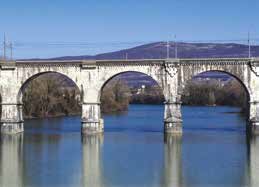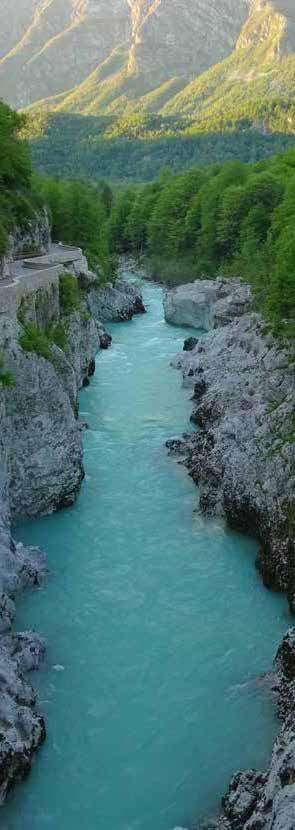glossary
AN EASY-TO-USE
REFERENCE TOOL
Similar structures match bridges in construction complexity but fulfill different functions:
- Flyovers which are road passovers that cross other roads
- Elevated roadways which pass over parts of urban areas
- Railway bridges which enable trains to cross
- Footbridges which accommodate pedestrians and cyclists
Bridges can be classified by their primary
construction material:
- Wooden bridges
- Stone bridges
- Reinforced concrete bridges
- Prestressed reinforced concrete bridges
- Steel bridges
- Girder bridges consisting of one or more beams anchored to support piers
- Arch bridges featuring an arch structure that serves as the primary load-bearing element
- Frame bridges utilising an articulated system of load-bearing components;
- Trestle bridges comprising a main girder supported by two struts
- Cable-stayed bridges where stay cables extend from the towers to support the structural deck
- Suspension bridges where steel cables form a catenary curve between pylons or towers, supporting the deck with vertical hangers
Regarding the combination of different structural models:
- Bridges that integrate arch and beam where the two elements coexist and work together structurally
Arch: a curved structure made of steel, reinforced concrete, wood, or other materials that exerts thrust at its base and anchors firmly to its supports. The deck attaches to the arch at varying heights, creating three distinct types: deck arch bridges, through-arch bridges, and half-through arch bridges.
Beams: longitudinal structural elements made of various materials (wood, steel, reinforced concrete, prestressed concrete) with different construction forms (truss, T-shaped, double-T, etc.) that define their structural behaviour.
Bridge length: the total length of the bridge structure.
Centering: a temporary structure, often of complex construction, that supports a curved load-bearing structure during building. The building materials (stone, bricks, reinforced concrete) rest on this framework until the structure becomes self-supporting.
Chord: the width of an arch at the piers.
Crossbeam: a structural element (beam) set perpendicular to the main beams; it acts as a secondary support structure in a system of longitudinal elements (main beams).
Deck: the horizontal element that forms the bridge’s surface, consisting of a structural component (main beam or beams), connecting layers, and surface finish.
Expansion joint: a connecting element between deck sections that allows the structure to expand and contract with temperature changes.
Footbridge: a structure designed exclusively for pedestrian and bicycle traffic.
Foundations: : base structures that distribute the bridge’s weight to the ground. They can be either direct or indirect (using piles). In suspension bridges, the foundation blocks —also called anchorages — specifically anchor the structural cables to the ground.
Hangers: metal cables that anchor (suspend) the structural deck to the structural cable, thus forming the suspension system.
Piers, Pillars, Pylons: vertical structural elements that support and transfer the bridge load to the foundation system. These elements serve as the bridge’s intermediate support structures. They may also be called intermediate bridge structures.
Pier cap: technical element that provides support between the bridge deck and pier/pillar.
Piers: technical elements that connect the deck to the underlying supporting structure.
Rise: the vertical distance between the highest point on the intrados and the chord.
Roadway width: the total width of the bridge deck that encompasses pedestrian walkways, bicycle paths, road shoulders, driving lanes, and safety zones.
Span: the distance between two consecutive piers, which are the points where the loads from the upper structure are transferred to the ground.
Stay cables: steel cables that extend diagonally from the towers to directly support the bridge deck.

Structural Bearings: devices made of specialised materials and mechanisms that transfer loads between the bridge deck and the pier caps.
Structural cable: a high-strength flexible steel component that serves as the main structural element of a suspension bridge. The cable, supported by towers or pylons, takes a catenary shape when unloaded and shifts to a parabolic form when bearing weight.
Support: elements that restrict the movement or position of a structural element (like a beam) using various types of support (fixed, simple, roller, or pinned).
Towers or Pylons: linear structures with heights proportional to the bridge span length. They rise above the deck, and in suspension bridges, they support the main structural cable, which holds the deck through vertical hangers. In cable-stayed bridges, they anchor the stays that directly support the deck.
Truss structure: complex framework of beams joined together at points called nodes, following the rigid geometry of the triangle. The vertical elements are called posts, the inclined ones diagonals, and the horizontal ones chords.
Tie: a linear element made of wood or reinforced concrete that supports rails in rail infrastructures.


IN ITS CURRENT
LIKE ONE OF ITS OWN STONES
I HOISTED MYSELF
UP AND WENT
LIKE AN ACROBAT
OVER THE WATER
I SQUATTED DOWN
NEAR MY CLOTHES
FOUL WITH WAR
AND LIKE A BEDOUIN
BOWED DOWN TO RECEIVE
THE SUN
THIS IS THE ISONZO
AND HERE I HAVE
BEST KNOWN MYSELF TO BE
AN OBEDIENT NERVE
OF THE UNIVERSE
written in Cotici on 16 August 1916
Translated by Patrick Creagh (1930 – 2012)


